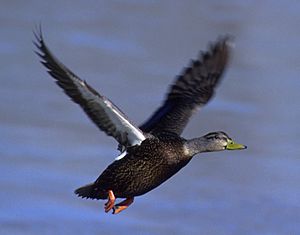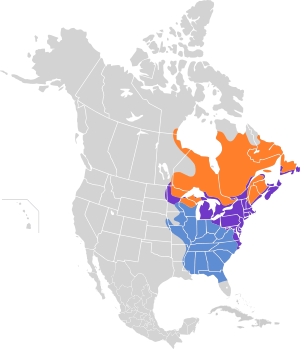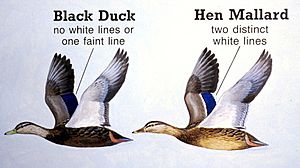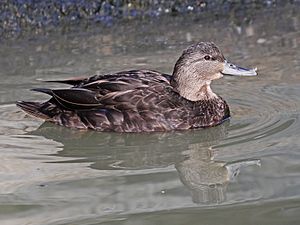American black duck facts for kids
Quick facts for kids American black duck |
|
|---|---|
 |
|
| American black duck in flight | |
| Conservation status | |
| Scientific classification | |
| Genus: |
Anas
|
| Species: |
rubripes
|
 |
|
The American black duck (Anas rubripes) is a large dabbling duck. It belongs to the Anatidae family, which includes ducks, geese, and swans. This duck was first described by William Brewster in 1902.
It is the heaviest duck in its group, Anas. An American black duck usually weighs between 720 and 1,640 grams (1.6 to 3.6 pounds). It measures about 54 to 59 centimeters (21 to 23 inches) long. Its wingspan can be 88 to 95 centimeters (35 to 37 inches).
This duck looks a bit like a female mallard, but it has darker feathers. Male and female black ducks look similar. However, the male's bill is yellow. The female's bill is dull green with dark spots on the top part.
American black ducks live in eastern North America. During their breeding season, they are found in wetlands from Saskatchewan in Canada to the Atlantic coast. They also live near the Great Lakes and in the Adirondack Mountains in the United States. These ducks are partially migratory. Most of them spend winter in the east-central United States, especially near the coast.
American black ducks often breed with mallards because they are closely related. The female lays 6 to 14 oval eggs. These eggs are smooth and can be white or buff green. It takes about 30 days for the eggs to hatch. The parents share incubation duties, which usually lasts 25 to 26 days. The male often guards the nest until the female is halfway through incubating. Ducklings can fly after about six weeks. Once the eggs hatch, the mother duck leads her young to areas with plenty of insects and plants.
The International Union for the Conservation of Nature (IUCN) lists the American black duck as a species of least concern. This means it is not currently in danger of extinction. People have long hunted this duck. However, its population is decreasing. This is mainly due to habitat loss. Wetlands are being drained or filled for urbanization. Global warming and rising sea levels also harm their homes. The United States Fish and Wildlife Service works to protect their habitats. Other groups also help by restoring land and buying new areas for the ducks.
Contents
What is the American Black Duck?
The American black duck is a type of dabbling duck. This means it feeds by tipping its body forward in shallow water. It doesn't dive completely underwater. These ducks are known for their dark feathers. They are found in eastern North America.
How Was the American Black Duck Named?
The American black duck was first described by an American bird expert named William Brewster. He named it Anas obscura rubripes in 1902. This name means "red-legged black duck." He wanted to show the difference between two types of black ducks in New England. One was smaller with brownish legs. The other was larger with bright red legs and a yellow bill.
The larger duck was first called Anas obscura by a German naturalist named Johann Friedrich Gmelin in 1789. He based his description on the "Dusky Duck" from Welsh naturalist Thomas Pennant. The duck's current scientific name is Anas rubripes. Anas means "duck" in Latin. Rubripes comes from ruber (red) and pes (foot), meaning "red-footed."
What Does the American Black Duck Look Like?
The American black duck is a large duck. It weighs between 720 and 1,640 grams (1.6 to 3.6 pounds). It is about 54 to 59 centimeters (21 to 23 inches) long. Its wingspan is 88 to 95 centimeters (35 to 37 inches). It is the heaviest duck in its group, Anas. Males are a bit heavier, averaging 1.4 kilograms (3.1 pounds). Females average 1.1 kilograms (2.4 pounds).
The American black duck looks somewhat like a female mallard. However, the black duck's feathers are darker. Both male and female black ducks look similar. But the male has a yellow bill. The female's bill is dull green with dark spots on the top.
The duck's head is brown, but it's a bit lighter than its dark brown body. Its cheeks and throat have brown streaks. A dark streak goes through its crown and past its dark eye. The special speculum feathers on its wings are shiny violet-blue. They have mostly black edges. The duck's feet are orange with dark webbing.
Both male and female American black ducks make calls similar to mallards. The female makes a loud series of "quacks" that get lower in pitch.
How to Spot Them in Flight
When flying, you can see the white lining of their underwings. This stands out against their dark body and upper side. The purple speculum (a patch on the wing) does not have white bands. It rarely has a white edge. You can also see a dark crescent shape on the feathers under the middle of their wings.
Young Ducks
Young American black ducks look like adult females. But their belly feathers have broken, narrow pale edges. This makes them look slightly streaked instead of scalloped. Their overall color is browner, not as uniformly black. Young males have brownish-orange feet. Young females have brownish feet and a dusky grayish-green bill.
Where Do American Black Ducks Live?

The American black duck lives only in eastern North America. In Canada, they are found from northeastern Saskatchewan to Newfoundland and Labrador. In the United States, they live in northern Illinois, Michigan, New Jersey, Ohio, Connecticut, Vermont, South Dakota, central West Virginia, Maine, and along the Atlantic coast down to North Carolina.
These ducks can live in many different places. They are found in salt marshes along the coast, from the Gulf of Maine to coastal Virginia. They prefer freshwater and coastal wetlands in northeastern America. This includes brackish marshes, estuaries, and the edges of backwater ponds and rivers. They also live in beaver ponds and shallow lakes with sedges and reeds. You can also find them in bogs in boreal and mixed hardwood forests, and in forested swamps. Some ducks in Vermont live in kettle ponds surrounded by bog mats.
In winter, American black ducks mostly live in brackish marshes near bays. They also use farm marshes, flooded forests, farm fields, estuaries, and river areas. They often hide from hunters and other disturbances in protected brackish and fresh water areas.
American Black Duck Behavior
What Do American Black Ducks Eat?
The American black duck eats many different things. It is an omnivore, meaning it eats both plants and animals. It finds food by dabbling in shallow water or by eating plants on land.
Its plant diet includes many types of wetland grasses and sedges. They also eat the seeds, stems, leaves, and roots of aquatic plants. Examples are eelgrass, pondweed, and smartweed. Their animal diet includes mollusks, snails, amphipods, insects, mussels, and small fish.
During the breeding season, about 80% of their diet is plants and 20% is animals. In winter, the animal part of their diet increases to 85%. When they are nesting, they eat more invertebrates. Young ducklings mostly eat water invertebrates for the first 12 days after hatching. This includes aquatic snowbugs, snails, mayflies, dragonflies, beetles, flies, caddisflies, and their larvae. After that, they start eating seeds and other plant foods.
How Do American Black Ducks Breed?
American black ducks breed in places like alkaline marshes, acid bogs, lakes, ponds, rivers, and estuaries. These areas are found in northern Saskatchewan, Manitoba, Ontario, Quebec, and the Atlantic Canadian Provinces. They also breed in the Great Lakes region and the Adirondack Mountains in the United States.
Many black ducks migrate south for winter. They spend winter in the east-central United States, especially coastal areas. Some stay year-round in the Great Lakes region. Sometimes, these ducks fly far away to places like Great Britain and Ireland. There, they might breed with local mallards. The mixed offspring can be hard to identify.
Black ducks build their nests on the ground. They are usually well-hidden, often in higher areas. A clutch of eggs has 6 to 14 oval eggs. They have smooth shells and can be white or buff green. On average, the eggs are 59.4 millimeters (2.3 inches) long and 43.2 millimeters (1.7 inches) wide. They weigh about 56.6 grams (2 ounces).
It takes about 30 days for the eggs to hatch. The incubation period is usually 25 to 26 days. Both parents help with incubation. However, the male often guards the area until the female is halfway through incubating. It takes about six weeks for the young ducks to be able to fly. Once the eggs hatch, the mother duck leads her ducklings to areas with lots of insects and plants.
American black ducks often breed with mallards. They are very closely related. Some experts even think the black duck is just a type of mallard, not a separate species. However, others argue that breeding with another species doesn't mean they are the same species.

It's thought that American black ducks and mallards used to live in different places. Black ducks might have preferred shaded forest ponds in eastern North America. Their dark feathers would have helped them hide. Mallards might have preferred brighter, open areas like prairie lakes. Their lighter feathers would have been better there. But now, forests have been cut down in the east, and trees have been planted on the plains. This might have caused the ducks to mix more and breed together.
However, we don't know how much they bred in the past. It's just assumed it was less than now. Also, many animal groups that breed together still stay separate species. It's hard to tell American black ducks and mallards apart using some genetic tests. But even if they look similar genetically, they can still have other differences.
Studies in captivity show that when black ducks and mallards breed, the female offspring often die before they can have their own young. This supports the idea that the American black duck is its own species.
Who Hunts American Black Ducks?
The main predators of American black duck nests are American crows, gulls, and raccoons. This is especially true for nests in trees. Hawks and owls also hunt adult ducks. Bullfrogs and snapping turtles eat many ducklings.
Ducklings can get sick from tiny parasites. These parasites are spread by insect bites, like from blackflies. Ducks can also get lead poisoning from eating lead shot. This happens because they often search for food at the bottom of ponds and wetlands.
Status and Conservation
Since 1988, the American black duck has been listed as "Least Concern" on the IUCN Red List of Endangered Species. This means it is not currently at high risk of extinction. The duck lives in a very large area. Its total population is also large. Even though the population is going down, it's not falling fast enough to make the species vulnerable.
The American black duck has long been a popular game bird. It is known for being very careful and fast-flying. The main reasons for its declining population are habitat loss. This includes wetlands being drained or filled for cities. Global warming and rising sea levels also destroy their homes. Some people worry that breeding with mallards could also be a problem if the population keeps declining.
The United States Fish and Wildlife Service buys and manages habitats for the American black duck. This helps them during migration, in winter, and during breeding season. For example, the Montezuma National Wildlife Refuge has bought and restored over 1,000 acres of wetlands. This provides a resting place for over 10,000 American black ducks during their fall migration.
The Atlantic Coast Joint Venture also protects black duck habitats. They do this by restoring land and buying new areas. These efforts mostly focus on the ducks' wintering and breeding grounds. In 2003, a plan called the Boreal Forest Conservation Framework was created. This plan helps protect the Canadian boreal forests. This includes the eastern Canadian breeding areas of the American black duck.
Images for kids
-
Anas rubripes female, Hudson River, New Jersey, USA
-
Chart showing differences between the American black duck and the female mallard
See also
 In Spanish: Ánade sombrío para niños
In Spanish: Ánade sombrío para niños












